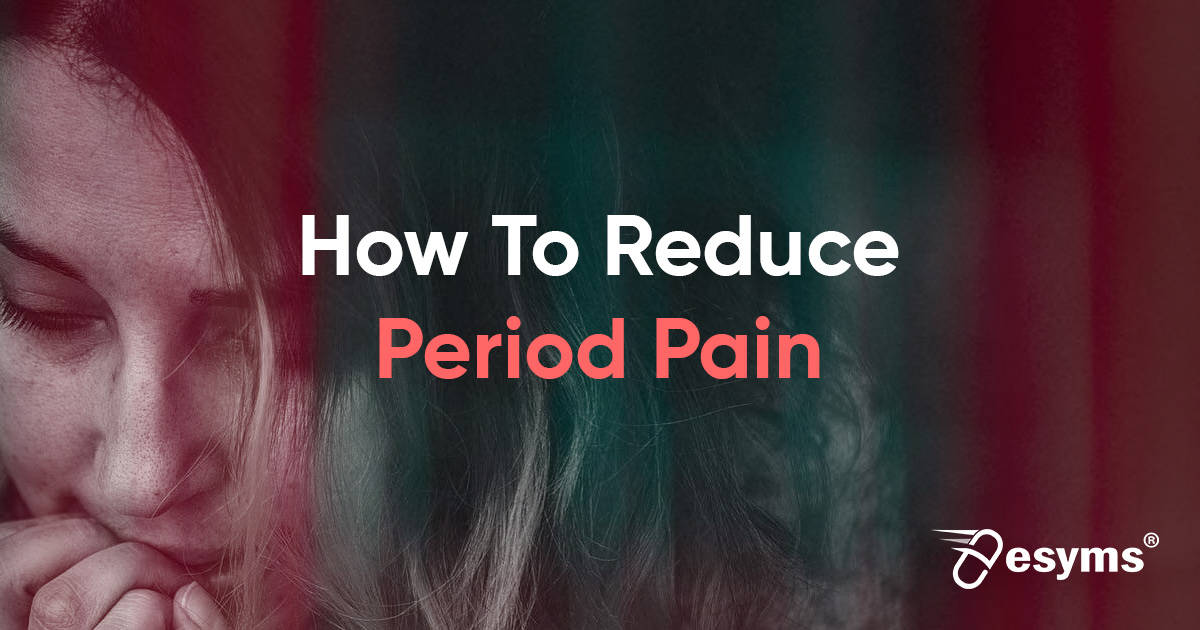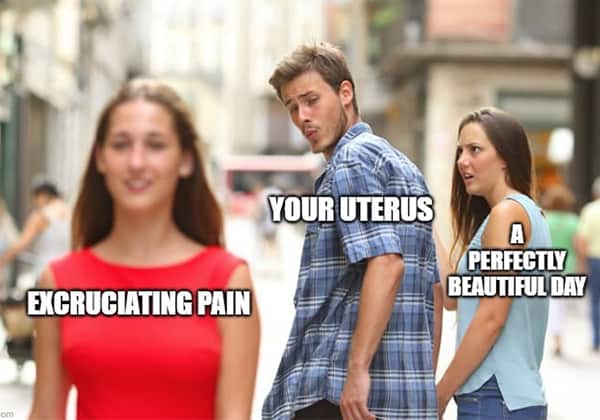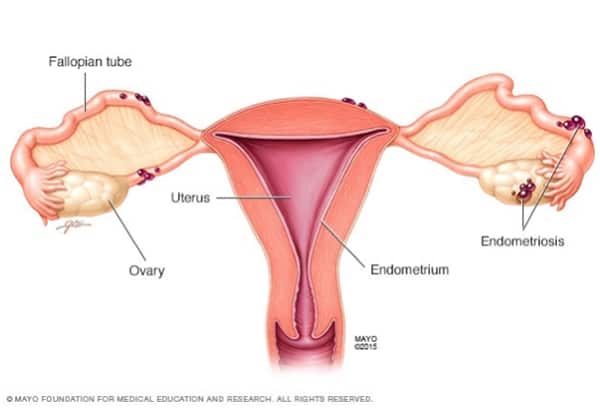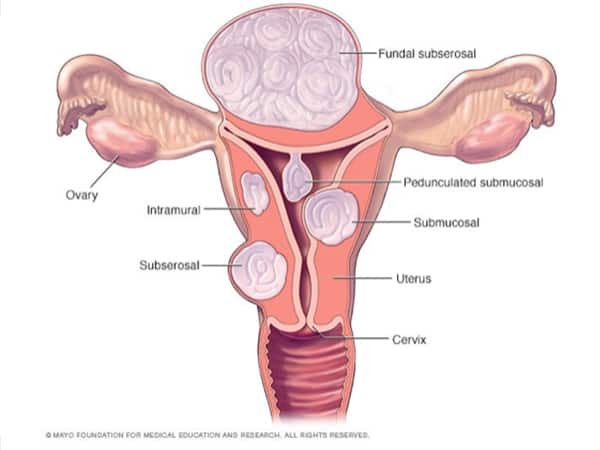How To Reduce Period Pain — Advice From A Pharmacist

- Esyms Team
- August 18, 2020
- 8:55 am
- No Comments
SHARE THIS ARTICLE
BROWSE OUR GUIDE
Introduction
We have all been there. It’s either you are the one experiencing it, or you have been with someone who has experienced it.
No, I’m not talking about love.
I’m talking about period pain.
No matter which phase in life you are at the moment, you are bound to recognise the debilitating symptoms of this condition.

What is period pain?
Period pain, or dysmenorrhoea, is defined as pain associated with menstruation. There are 2 main types of dysmenorrhoea, primary and secondary. Let’s look at the difference between these 2.
Primary Dysmenorrhoea
This is the more common form of period pain which is caused mainly by the contraction of the uterine muscles. This contraction is caused by a chemical known as prostaglandins, which are produced in the lining of the uterus. At the beginning of the menstrual cycle, especially the first day when the uterine wall is the thickest, the level of prostaglandins is also high. This causes more frequent contractions which leads to pain. As the wall is shed throughout menstruation, the level falls and so does the pain.
Secondary Dysmenorrhoea

- Endometriosis: The lining of the uterus is known as the endometrium. In endometriosis, these tissues are found outside the uterus. This means that organs such as your fallopian tube or ovaries might have growth of these tissues. These tissues are shed during menstruation, but unlike normal menstruation, the tissues have no way of exiting the region and are thus trapped. This causes irritation and can lead to scar tissue formation.
- Adenomyosis: A condition where the uterine tissues grow into the muscles of the uterus. These tissues act normally which means they shed during menstruation. People who suffer from adenomyosis often experience heavy periods.
- Pelvic inflammatory disease (PID): PID is caused by bacteria infection in the female reproductive organ. This is usually caused by a sexually transmitted disease which originates from the vagina and spreads to organs like the uterus and fallopian tube. Signs and symptoms of PID can be mild, which is why some people who get it might not realise until they have difficulty getting pregnant or they experience severe pelvic pain.
- Uterine fibroids: You have probably heard of this one. Fibroids are noncancerous growths of the uterus. Worry not as these growths are benign and they are often not associated with uterine cancer. The sizes can range from as small as it being undetectable to as big as it being able to distort the uterus. More often than not, people who have fibroids do not even know that they have them, until they experience pain in the pelvic region.

How do I reduce the period pain?
Here comes the million-dollar question. How do you reduce the pain? Pain is a fairly subjective term and some might have it worse than others. But we can all agree on one thing: it’s really uncomfortable.
So, here are some tips in alleviating the dreadful pain the next time the cycle starts.
1) Over the counter medications
As some people say, when you’re in pain, throw in a Panadol! The most direct and effective method in curing pain is by, you’ve guessed it, taking a painkiller. Medications such as paracetamol (Panadol) and ibuprofen can be a quick way of taking the pain away. You can also look out for ones which have the word ‘menstrual’ on it as these come with an extra ingredient – pamabrom. As one may experience water-retention during menstruation, pamabrom is a diuretic which relieves this symptom. This together with the painkilling effect can provide much needed comfort.
Side note: We have plenty of Panadol options available at amazing discounts on the esyms store.
2) Heat therapy
Heat therapy is a fairly common method in reducing period pain. There are a variety of heat producing patches in the market and they work by relaxing the abdominal muscles thus reducing the pain from contractions. Some common ingredients that can be found in these patches are capsaicin (the chemical which makes chillies spicy) and menthol. Besides patches, something as simple as a warm shower can also help with the cramps.
3) Exercise
Many people experience mood swings during or before their menstruation and exercising can actually help. Endorphins which are the bodies’ natural painkiller are released during exercise and this can help improve mood and reduce pain. One can be extremely fatigued during the first few days of period, which is why it is important to pick lighter exercises or routines.
4) Sanitary pads
You must be thinking, what does a sanitary pad got to do with period pain? Technology in sanitary pads have since come a long way and there are products in the market which claim to potentially lessen period pain in the long run. Check out some of best sanitary pads on esyms.
5) Get your diet right
There are a few foods which you can avoid during menstruation. Here are a few examples:
- Salt: Salt increases water retention in the body and if you recall in point #1, its something you wish to get rid of.
- Alcohol: Too much alcohol can leave you dehydrated and this can cause headaches which may worsen your pain.
- Spicy food: Spicy food may cause diarrhoea and stomach pain. Paired with your menstrual ache, it might leave you feeling extremely unwell.
- Cold food / drink: While there may be a lack of scientific evidences when it comes to the correlation between cold foods and period cramps, there are anecdotal evidences. However, this might not be the case for everyone.
- Sugary food / drinks: Consuming a large amount of sweet and sugary drinks may give you a spike of energy and then leave you feeling more lethargic and tired during this period of time
In summary
There you have it! Menstruation is a delicate process and it is important to acknowledge that it can be severely debilitating at times. Therefore, even if you are a guy reading this, it is useful to know the intricacies of this cycle. For more advice relating to menstrual pain or the works, don’t hesitate to reach out to our pharmacists.
Now that you’ve made it to the end of this article, if you are someone who is going through period pain, go make yourself a hot chocolate, snuggle into your comfy pyjamas, and have a good rest.
You’ve done well, girl.
References
- https://www.mayoclinic.org/diseases-conditions/endometriosis/symptoms-causes/syc-20354656
- https://www.acog.org/patient-resources/faqs/gynecologic-problems/dysmenorrhea-painful-periods
- https://my.clevelandclinic.org/health/diseases/4148-dysmenorrhea
- https://www.mayoclinic.org/diseases-conditions/pelvic-inflammatory-disease/symptoms-causes/syc-20352594
- https://www.mayoclinic.org/diseases-conditions/uterine-fibroids/symptoms-causes/syc-20354288
- https://www.healthline.com/health/exercise-during-period#benefits
